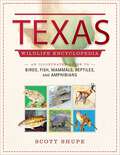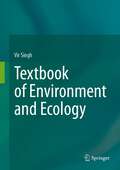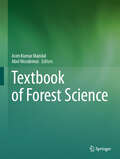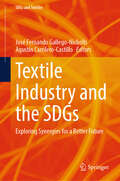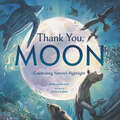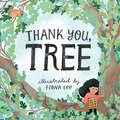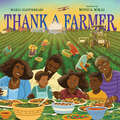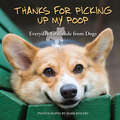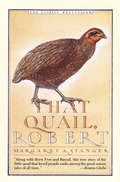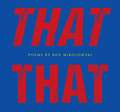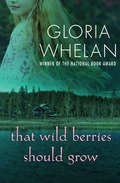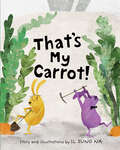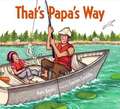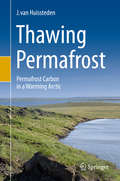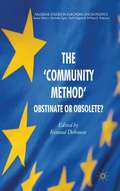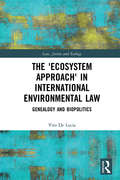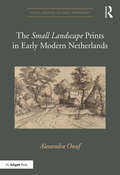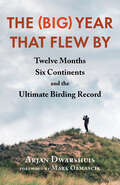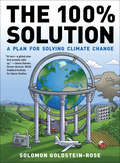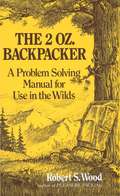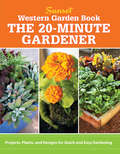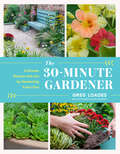- Table View
- List View
Texas Wildlife Encyclopedia: An Illustrated Guide to Birds, Fish, Mammals, Reptiles, and Amphibians
by Scott ShupeIncluded are over 700 color photographs, depicting the different species of mammals, reptiles, amphibians, birds, and fish, while offering over 600 range maps to show their territory, along with basic information for the biology of each animal, Texas's wildlife has always played an important role in the history of human beings inhabiting the state. Although the state&’s wildlife is still an important resource for human consumption, wildlife is also increasingly important in today&’s culture for its intrinsic, aesthetic value. For many Texans, the age-old traditions of hunting and fishing have been replaced by a desire to simply observe wildlife and experience nature. But most Texans are largely unaware of the diversity of species inhabiting their state. This volume is intended to provide an introduction to the state&’s freshwater fishes, amphibians, reptiles, birds, and mammals. In Texas Wildlife Encyclopedia, nationally known naturalist Scott Shupe has collected information on all the native wildlife that reside in the Lone Star State. The seventh in a series of state wildlife encyclopedias, this book will be a handy, usable, layman&’s guide to Texas's native wildlife. Shupe includes the size, habitat, and abundance of each species located in the state. Whether you&’re a lover of the outdoors, photography, or are looking to learn more about your state, this comprehensive guide will teach you about the wonderful wildlife that covers the water, earth, and skies of Texas.
Textbook of Environment and Ecology
by Vir SinghThis textbook is focused on fundamentals of environment and ecology for undergraduate and graduate students. This is first of its kind book dealing with physical environment, ecosystems, biological diversity, environmental pollution, and environment-influenced natural resource ecology and management. This will cater to the needs of the students, examinees, trainees, and teachers. It consists of 23 chapters spread over 5 sections i.e., ecosystem analysis, natural resources, biodiversity, environmental disruptions, and environmental management. The textbook is well aligned with the syllabus of all central and state universities and offers the latest insights as well to the students of undergraduate and postgraduate courses of ecology and environmental sciences. Every chapter provides summary/points to remember and exercises. Each exercise includes 20 multiple-choice questions, 10 short-answer questions, and 5 long-answer questions. The textbook is a comprehensive coverage for basic and advanced courses in ecology and environmental sciences. Each topic is supported by illustrations, tables, and information boxes etc.
Textbook of Forest Science
by Asim Kumar Mandal Abel NicodemusThis textbook presents the latest knowledge on various disciplines of forestry science presented in 39 chapters. Each chapter presents a reappraisal of theory and practice, applications and future scope of subject area. It is a single point reference for updated information on both traditional and contemporary areas of forestry. Some of the disciplines covered in the book are biotechnology, remote sensing, forest certification, forest management, forest hydrology, climate change, plantation and urban forestry, biodiversity and genetic resources conservation, wildfire science, seed science and quality seed production and ecosystem services. The book primarily serves as an advanced textbook of forest science for students of forestry at all levels. The science of forestry is receiving much more attention of the researchers, policy makers, andl public than ever before because of growing awareness of vital importance of forests in amelioration of world environment. This book is a comprehensive collection of existing and new methods including outcome and future possibilities of forest science. This book benefits undergraduate and postgraduate students, professional researchers, teachers, practicing foresters, and policy planners. The book also encourages the public to understand the relevance of forest science to overcome the contemporary economic and environmental challenges.
Textbook of Pistols and Revolvers: Their Ammunition, Ballistics and Use
by Julian S. HatcherOriginally published in 1935, Textbook of Pistols and Revolvers is a treatise on handguns of the early twentieth century. Written by Major Julian S. Hatcher, an expert on the subject of firearms of all sorts, readers will gain invaluable insight into everything to do with handheld firearms of the 1930s.In his introduction, Hatcher emphasizes that he has made an earnest effort to make this book accessible for both novices and experts. Novices who know nothing whatsoever about firearms and their use can easily learn from this book, while experts will find a technical reference book where "the results of many experiments with pistols and revolvers and their ammunition are tabulated in convenient form."Covering such subjects as the different methods of shooting and using hand firearms; their mechanism, care and repair; their interior and exterior ballistics; the peculiar suitability of the different kinds for various purposes; the relative effectiveness or stopping power of the various calibers and types of gun and ammunition; and many more, this book is an immense store of knowledge on early handguns.
Textile Industry and the SDGs: Exploring Synergies for a Better Future (SDGs and Textiles)
by José Fernando Gallego-Nicholls Agustín Carrilero-CastilloThis book offers an exploration of the textile industry and their relationship to the Sustainable Development Goals (SDGs), catering specifically to academic researchers and providing a roadmap for aligning aligning textile research with the SDGs. It covers a wide range of topics, starting with an overview of the SDGs and their relevance to the textile industry. It examines the environmental footprint of textiles, including issues related to raw material sourcing, manufacturing processes, and waste management. Additionally, it explores the social and economic aspects of textiles, such as labor conditions, fair trade, and responsible consumption. One of the main focuses of this book is the role of innovation and technology in advancing sustainable textiles. It discusses emerging materials and technologies that promote circularity, reduce environmental harm, and enhance social well-being. Furthermore, it explores the potential of digitalization, artificial intelligence, and data analytics in optimizing textile production, distribution, and consumption patterns. This book also addresses the challenges and opportunities associated with sustainable textile supply chains. It analyzes the complexities of global value chains, the need for transparency and traceability, and the importance of collaboration among stakeholders. Furthermore, it highlights strategies for promoting sustainable fashion, encouraging responsible consumption, and fostering circular business models. By delving into these topics, this book aims to solve several key problems faced by academic researchers in the field of textiles and sustainability. It provides a holistic understanding of the SDGs and their integration into textile research, helping researchers align their work with broader sustainability objectives. It offers insights into the latest innovations and technologies, enabling researchers to explore cutting-edge solutions for sustainable textiles. Additionally, it presents case studies and best practices from industry leaders, inspiring researchers to undertake impactful research and contribute to positive change. This book is intended for academic researchers, as well as practitioners, specializing in textiles, sustainability, and related fields. It serves as a valuable resource for professors, postgraduate students, and professionals seeking to deepen their knowledge of the interplay between textiles and the SDGs. It encourages critical thinking, fosters interdisciplinary collaboration, and equips researchers with the tools and insights necessary to drive sustainable transformations within the textile industry and beyond.
Thank You, Moon: Celebrating Nature's Nightlight
by Melissa StewartWith the soothing rhythm of a bedtime story and the scientific wonder of a nature doc, comes a celebration of the moon and all the creatures who rely on its light to find their way home.Under the glow of a shimmering moon, creatures great and small creep out of their dens, using its light to hunt, fend off predators, build their nests or build families. As the moon changes phases these animals adapt their behavior to match its waxing and waning—while human animals look on in wonder.As Earth's closest companion in space, the moon has fascinated humankind for generations, and this nonfiction picture book sheds light on the mysterious ways it affects life on Earth. With luminous illustrations by Jessica Lanan and a lyrical text that is part lullaby and part scientific resource, Thank You, Moon is a treasure for all ages to enjoy.
Thank You, Tree: A Board Book
by Editors of Storey PublishingOn every page of this beautiful board book, Fiona Lee's charming illustrations invite little ones to celebrate a wonderful tree, learn its name, and say thank you for the tree&’s joyful, natural gifts. From thanking a magnolia tree for its pink blossoms and a birch tree for a branch to swing on to thanking a maple tree for its colorful fall leaves and a cedar for a secret hiding place, this sweet book teaches the youngest readers to celebrates trees for their leaves, branches, flowers, fruits, and more.
Thank a Farmer
by Maria GianferrariInfused with jubilance and warmth, this luminous, lyrical picture book celebrates the people and the work that put food on our tables. Bread, milk, wool, fruits, and vegetables: things that fill our day to day lives. But where, and who, do they come from? Across wheat fields and city rooftop gardens, mushroom beds and maple forests, Thank a Farmer traces the food and clothing that a family uses back to the people who harvested and created them. With Maria Gianferrari’s informed and poetic text and monumental artwork from Monica Mikai, Thank a Farmer gently emphasizes the importance of agriculture in our day-to-day lives and reminds readers to give thanks to farmworkers around the world.
Thanks for Picking Up My Poop: Everyday Gratitude from Dogs
by Editors of Ulysses PressAdorable dogs paired with the hilarious, heartwarming reasons they love their weird-looking, fur-less human companions.Honorable Mention for Pets—Foreword Indies Book of the Year AwardsHave you ever considered what our precious pooches would say to us if they could speak?In Thanks for Picking Up My Poop, our cute and cuddly canine companions impart their humorous and heartfelt motivations for staying so dedicated to their sometimes-clueless caregivers.Packed with engaging photos and clever snippets of doggy wisdom, this book helps us mere humans better appreciate those moments of happiness we share with others every day.“A fun and cute present for dog lovers.” —Abilene Reporter News“Who has not lived in fear of how they will be able to waste time when their internet is down? . . . Just add this little book to your emergency supplies (next to the deck of cards). It doesn’t take up much room, and has gobs of the pictures and captions you need.” —Kennett Veterinary Clinic
That Mushy Stuff (Pee Wee Scouts #8)
by Judy Delton[from the back cover] "Everyone knows that Roger White likes Patty Baker. Patty-cake, patty-cake, baker's man. The Pee Wee Scouts tease Roger and Patty during their Scout meeting. Mrs. Peters is their troop leader. She tells the Pee Wee Scouts how to earn badges for first aid. Then she helps them make valentines that hold messages. Secret messages. Poems. All that mushy stuff. "I want a boyfriend," says Molly Duff. 'And I want a first-aid badge." Busy, busy busy. The Scouts work on valentines and first aid. Molly works on a secret plan. Uh-oh. A certain Scout better watch out!" The Pee Wees goof around, do good deeds, take on projects and have fun and adventures. Find out all about what scouts do in the many Pee Wee Scout books you can get from Bookshare including: #1 Cookies and Crutches, #2 Camp Ghost-Away, #3 Lucky Dog Days, #4 Blue Skies, French Fries, #5 Grumpy Pumpkins, #6 Peanut-Butter Pilgrims, #7 A Pee Wee Christmas, #9 Spring Sprouts, #10 The Pooped Troop, #11 The Pee Wee Jubilee, #12 Bad, Bad, Bunnies, #13 Rosy Noses, Frozen Toes, #14 Sonny's Secret, #15 Sky Babies, #16 Trash Bash, #17 Pee Wees On Parade, #18 Lights, Action, Land-ho!, #19 Piles of Pets, #20 Fishy Wishes, #21 Pee Wees On Skis, #22 Greedy Groundhogs, #23 All Dads on Deck, #24 Tricks and Treats, #25 Pee Wees on First, #26 Super Duper Pee Wees, #27 Teeny Weeny Zucchinis, #28 Eggs With Legs, #29 Pee Wee Pool Party, #30 Bookworm Buddies, #31 Moans, Groans and Dinosaur Bones, and #33 Halloween Helpers, and there are more coming!
That Quail, Robert
by Margaret StangerThe acclaimed story of the little bird that won the nation's heart.
That That (Made in Michigan Writers Series)
by Ken MikolowskiPoet Ken Mikolowski ran a letterpress printing house for over thirty years, setting poems by hand, one letter at a time--an experience that influenced his love of short verse. In That That, Mikolowski presents his trademark quirky, humorous, and insighful poems, none longer than three brief lines and some made up of only two or three carefully chosen words. Together, these poems create a narrative of life and love broken down to the most minimal of forms. Mikolowski's deceptively simple collection takes readers on a whirlwind tour through weighty topics and humorous vignettes. He reflects on the nature of art, identity, and legacy in poems that muse in their entirety, "I've never met a deadline / I've ever met yet" and "Why I am not a New York poet / Detroit." Mikolowski also gives unparalleled assessments of serious subjects like love, aging, and death, declaring, "Sometimes / I don't think of you / for hours" and "Getting old / gets old / real quick." Some poems are more lighthearted and delight only in the wordplay of rhyme or unexpected imagery, adding an unmistakably playful element to this spare but polished volume. Mikolowski's collection demonstrates the singular power of language in the hands of a master craftsman. That That will be read and re-read by anyone interested in short poetry.
That Wild Berries Should Grow
by Gloria WhelanIn the depths of the Depression, a young girl goes to live in the country Although the Depression has destroyed Detroit's economy, Elsa cannot imagine living anywhere else. She loves her friends, her family, and the hustle and bustle of the great industrial city. But when a mysterious illness forces her to miss half of fifth grade, her parents take drastic action and send her to stay with her grandmama to heal. Not just for a week. Not just for a month. For the entire summer. Elsa is frightened of her stern German grandmother and doesn't think she could ever feel at home in the peaceful Michigan countryside. The nights are too quiet and the days are too boring, and she has nothing to amuse herself with except her journal. But as the Lake Huron summer wears on, Elsa learns to take joy in empty places and live for the beauty of nature.
That's My Carrot
by Il Sung NaFrom the acclaimed author-illustrator of A Book of Sleep comes a silly tale about a garden rivalry, a giant carrot and bunnies in construction vehicles!When two rabbits find a giant carrot growing between their yards, they do the only thing that makes sense: they argue over whose carrot it is! One rabbit brings a shovel to dig it out, and the other rabbit brings a spade. Next comes the bulldozers and backhoes and cranes . . . and when the dust settles, the carrot is gone! Now, it will be up to the rabbits to join forces and find the giant carrot, and build a friendship along the way.From beloved creator Il Sung Na comes a story of mischief and one very giant carrot.
That's Papa's Way
by Kate BanksPapa casts his line out into the water. I drop my line plumb with the edge of the boat. And we wait . . . It's early morning. The sun is rising like a big yellow balloon, and the water on the lake is still. It's the perfect time to catch fish. And for one little girl, it's also the perfect opportunity to spend time with her papa--watching how he plucks worms from the soil with his fingers, listening as he whistles with the swaying of the boat, and laughing as he quacks at the passing ducks. That, she knows, is Papa's way. The little girl has her way, too. And, as readers will discover, it's not always like Papa's. But that doesn't keep them from spending a glorious day together in this tender telling of a parent-child outing, which ends with a triumphant trip home and a feast for the whole family.
Thawing Permafrost: Permafrost Carbon in a Warming Arctic
by J. van HuisstedenThis book provides a cross-disciplinary overview of permafrost and the carbon cycle by providing an introduction into the geographical distribution of permafrost, with a focus on the distribution of permafrost and its soil carbon reservoirs. The chapters explain the basic physical properties and processes of permafrost soils: ice, mineral and organic components, and how these interact with climate, vegetation and geomorphological processes. In particular, the book covers the role of the large quantities of ice in many permafrost soils which are crucial to understanding carbon cycle processes.An explanation is given on how permafrost becomes loaded with ice and carbon. Gas hydrates are also introduced. Structures and processes formed by the intense freeze-thaw action in the active layer are considered (e.g. ice wedging, cryoturbation), and the processes that occur as the permafrost thaws, (pond and lake formation, erosion).The book introduces soil carbon accumulation and decomposition mechanisms and how these are modified in a permafrost environment. A separate chapter deals with deep permafrost carbon, gas reservoirs and recently discovered methane emission phenomena from regions such as Northwest Siberia and the Siberian yedoma permafrost.
The "Greening" of Costa Rica: Women, Peasants, Indigenous Peoples, and the Remaking of Nature
by Ana IslaSince the 1992 Earth Summit in Rio de Janeiro, the concept of sustainable development has become the basis for a vast number of "green industries" from eco-tourism to carbon sequestration. <P><P>In The "Greening" of Costa Rica, Ana Isla exposes the results of the economist's rejection of physical limits to growth, the biologist's fetish with such limits, and the indebtedness of peripheral countries. <P><P>Isla's case study is the 250,000 hectare Arenal-Tilaran Conservation Area, created in the late 1990s as the result of Canada-Costa Rica debt-for-nature swaps. <P><P> Rather than reducing poverty and creating equality, development in and around the conservation area has dispossessed and disenfranchised subsistence farmers, expropriating their land, water, knowledge, and labour. <P><P>Drawing on a decade of fieldwork in these communities, Isla exposes the duplicity of a neoliberal model in which the environment is converted into commercial assets such as carbon credits, intellectual property, cash crops, open-pit mining, and eco-tourism, few of whose benefits flow to the local population.
The 'Community Method'
by Renaud DehousseSixty years after its invention, the operational system of the European Union remains little-understood. The 'Community Method' provides a comprehensive empirical analysis of the functioning and achievements of the EU.
The 'Ecosystem Approach' in International Environmental Law: Genealogy and Biopolitics (Law, Justice and Ecology)
by Vito De LuciaThe ecosystem approach, broadly understood as a legal and governance strategy for integrated environmental and biodiversity management, has been adopted within a wide variety of international environmental legal regimes and provides a narrative, a policy approach and in some cases legally binding obligations for States to implement what has been called a ‘new paradigm’ of environmental management. In this last respect, the ecosystem approach is also often considered to offer an opportunity to move beyond the outdated anthropocentric framework underpinning much of international environmental law, thus helping re-think law in the Anthropocene. Against this background, this book addresses the question of whether the ecosystem approach represents a paradigm shift in international environmental law and governance, or whether it is in conceptual and operative continuity with legal modernity. This central question is explored through a combined genealogical and biopolitical framework, which reveals how the ecosystem approach is the result of multiple contingencies and contestations, and of the interplay of divergent and sometimes irreconcilable ideological projects. The ecosystem approach, this books shows, does not have a univocal identity, and must be understood as both signalling the potential for a decisive shift in the philosophical orientation of law and the operationalisation of a biopolitical framework of control that is in continuity with, and even intensifies, the eco-destructive tendencies of legal modernity. It is, however, in revealing this disjunction that the book opens up the possibility of moving beyond the already tired assessment of environmental law through the binary of anthropocentrism and ecocentrism.
The 'Small Landscape' Prints in Early Modern Netherlands (Visual Culture in Early Modernity)
by Alexandra OnufIn 1559 and 1561, the Antwerp print publisher Hieronymus Cock issued an unprecedented series of landscape prints known today simply as the Small Landscapes. The forty-four prints included in the series offer views of the local countryside surrounding Antwerp in simple, unembellished compositions. At a time when vast panoramic and allegorical landscapes dominated the art market, the Small Landscapes represent a striking innovation. This book offers the first comprehensive analysis of the significance of the Small Landscapes in early modern print culture. It charts a diachronic history of the series over the century it was in active circulation, from 1559 to the middle of the seventeenth century. Adopting the lifespan of the prints as the framework of the study, Alexandra Onuf analyzes the successive states of the plates and the changes to the series as a whole in order to reveal the shifting artistic and contextual valences of the images at their different moments and places of publication. This unique case study allows for a new perspective on the trajectory of print publishing over the course of the late sixteenth and early seventeenth centuries across multiple publishing houses, highlighting the seminal importance of print publishers in the creation and dissemination of visual imagery and cultural ideas. Looking at other visual materials and contemporary sources – including texts as diverse as humanist poetry and plays, agricultural manuals, polemical broadsheets, and peasant songs – Onuf situates the Small Landscapes within the larger cultural discourse on rural land and the meaning of the local in the turbulent early modern Netherlands. The study focuses new attention on the active and reciprocal intersections between printed pictures and broader cultural, economic and political phenomena.
The (Big) Year that Flew By: Twelve Months, Six Continents, and the Ultimate Birding Record
by Arjan Dwarshuis&“A fast-paced page-turner and a unique adventure story . . . filled with insights about landscapes, people, and a world of wonderful birds.&”―Kenn Kaufman, author of Kingbird HighwayAn epic tale of one passionate birder&’s record-breaking adventure through 40 countries over 6 continents—in just one year—to see 6,852 bird species, rare and common, before many go extinct.When Arjan Dwarshuis first heard of the &“Big Year&”—the legendary record for birdwatching—he was twenty years old, it was midnight, and he was sitting on the roof of a truck in the Andean Mountains. In that moment he promised himself that, someday, somehow, he would become a world-record-holding birder.Ten years later, he embarked on an incredible, arduous, and perilous journey that took him around the globe; over uninhabited islands, through dense unforgiving rainforests, across snowy mountain peaks and unrelenting deserts—in just a single year. Would he survive? Would he be able to break the &“Big Year&” record, navigating through a world filled with shifting climate and geopolitical challenges?The (Big) Year that Flew By is an unforgettable, personal exploration of the limits of human potential when engaging with the natural world. It is a book about birds and birding and Arjan&’s attempts to raise awareness for critically endangered species, but it is also a book about overcoming mental challenges, extreme physical danger, and human competition and fully realizing your passions through nature, adventure, and conservation.&“Dwarshius&’ exhilarating race against time across 40 countries and 6 continents in his attempt to break the world record will thrill armchair readers and bird enthusiasts alike.&”―Booklist&“I sped through [this] book, trying to ignore feelings of jealousy as Dwarshuis described moments with species I&’ve dreamed of seeing.&”—The Washington Post
The 100% Solution: A Plan for Solving Climate Change
by Solomon Goldstein-Rose"At last--a global plan that actually adds up."--James Hansen, former director, NASA Goddard Institute for Space StudiesThe world must reach negative greenhouse gas emissions by 2050 to avoid the most catastrophic effects of climate change. Yet no single plan has addressed the full scope of the problem--until now. In The 100% Solution, Solomon Goldstein-Rose--a leading millennial climate activist and a former Massachusetts state representative--makes clear what needs to happen to hit the 2050 target: the manufacturing booms we must spur, the moonshot projects we must fund, the amount of CO2 we'll have to sequester from the atmosphere, and much more. Most importantly, he shows us the more prosperous and equitable world we can build by uniting the efforts of activists, industries, governments, scientists, and voters to get the job done. This is the guide we've been waiting for. As calls for a WWII-scale mobilization intensify--especially among youth activists--this fully illustrated, action-oriented book arms us with specific demands, sets the stakes for what our leaders must achieve, and proves that with this level of comprehensive thinking we can still take back our future.
The 2 Oz. Backpacker: A Problem Solving Manual for Use in the Wilds
by Robert S. WoodThis featherweight little book will keep you out of trouble in the wilds by helping you make decisions like a veteran wilderness traveler. It will help you get the most from the food and gear you carry on your back, making your trip safer, more comfortable and, above all, more fun.HOW TO...make quick repairs to packs, boots, tents, beds and stoves...choose and develop a campsite for maximum comfort and shelter...deal with emergencies, storms and other difficulties...treat blisters, hypothermia, sunburn, bleeding, elevation sickness, etc... keep snug, dry, comfortable and warm in heavy weather.PLUS TIPS ON fire building, cooking, water treatment, getting found when lost, hiking, climbing, cross-country and route-finding techniques.From the Trade Paperback edition.
The 20 Minute Gardener: Projects, Plants and Designs for Quick & Easy Gardening
by Editors of SunsetIn the Western Garden Book: The 20-Minute Gardener learn the secret to achieving a beautiful garden with minimum effort, paying attention to it in brief time increments all week and season long rather than devoting long days on weekends. Make the process fun. Take an early-morning stroll through your garden, picking off spent blooms as you go, or in the evening after work; pull stray weeds or harvest tomatoes for dinner. This informative guide helps seasoned and new gardeners alike plan easy-to-tend garden spaces, choose low-maintenance plants, grow edibles that keep on giving (artichokes, asparagus, blueberries, citrus) and monitor your plants daily rather than weekly. With garden techniques and projects you will find all the tips and step-by-step instruction needed to create a stylish yet easy-to-maintain outdoor space.
The 30-Minute Gardener: Cultivate Beauty and Joy by Gardening Every Day
by Greg LoadesFind happiness, connection, and accomplishment by cultivating your garden life every day of the week using this inspiration-packed guide that shows aspiring gardeners exactly what they need to know. Are you ready to discover your garden&’s unexpected gifts? All it takes is a daily practice. In The 30-Minute Gardener, Greg Loadesreveals what dedicated time spent in the garden every day can create: a moment of solitude in a busy world, a welcoming space to enjoy with family and friends, and an increased connection to nature. In this practical and inspiring guide you&’ll find advice on tasks such as pruning a rose bush and planting bulbs, inspired ideas for transforming an overgrown garden into a beautiful flower-filled haven, and hints on how best to savor your garden and enjoy your accomplishments.
